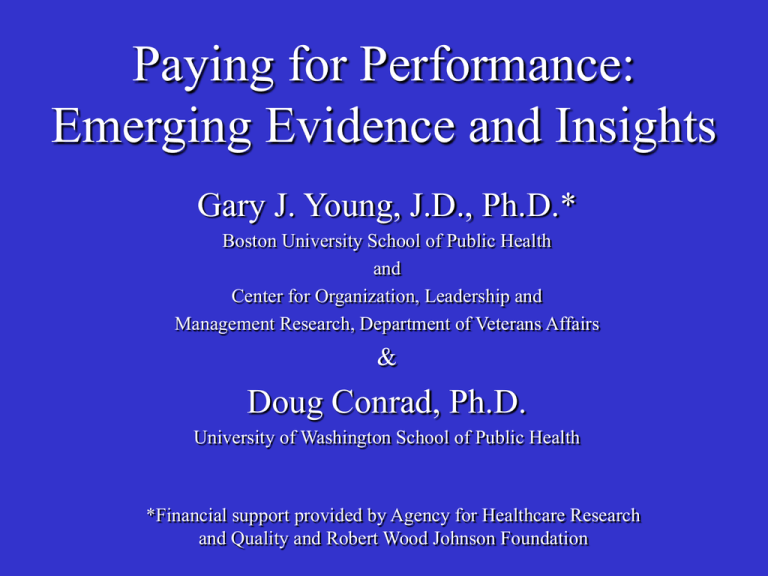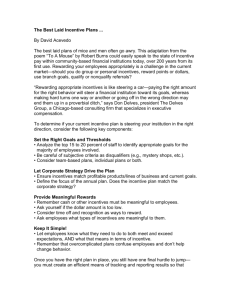Overview of Pay-for- Performance (P4P) Programs
advertisement

Paying for Performance: Emerging Evidence and Insights Gary J. Young, J.D., Ph.D.* Boston University School of Public Health and Center for Organization, Leadership and Management Research, Department of Veterans Affairs & Doug Conrad, Ph.D. University of Washington School of Public Health *Financial support provided by Agency for Healthcare Research and Quality and Robert Wood Johnson Foundation What is Pay-for-Performance (P4P)? • Financial incentive • Predefined performance target – efficiency, productivity, QUALITY • Target recipient – individuals, teams, organizations 2 Over 100 P4P Programs with Quality Targets Examples: • Excellus/Rochester Individual Practice Association – individual physicians • Blue Cross of California (PPO) -- individual physicians • Center for Health Care Strategies, Medicaid (CA) – individual physicians and physician group practices • Blue Cross Blue Shield of Michigan – hospitals • Centers for Medicare & Medicaid Services – Medicare participating hospitals and physician group practices 3 Why P4P? • Quality problems • Escalating costs – business case for quality • Managed care not a silver bullet 4 Will P4P Work? • Evidence from manufacturing sector is promising • Evidence from health care sector is both limited and mixed 5 What do P4P Programs Look Like? 6 P4P: Quality Target • Chronic Conditions Examples: •HbA1c testing: threshold • Primary care providers •Diabetic eye exam: threshold • Process-oriented quality targets (HEDIS) •Mammography: threshold •Well-child visits: % improvement 7 P4P: Target Recipient • Group physician practice/IPA • Hospitals • Individual physicians 8 P4P: Financial Incentive Arrangements • Cash lump sum bonuses • Fee schedule adjustments • PMPM bonus potential for total panel (e.g., $1.50 PMPM; $3.00 PMPM) • Withhold adjustments • Withhold/bonus hybrid 9 P4P: Payout Formulas Components: • Clinical quality measures (HEDIS, homegrown, outcome control) • Utilization – total medical expense trends • Information systems • Patient access and satisfaction Scoring: • Thresholds • %Improvement • Rankings 10 P4P: Non-Financial Incentive Arrangements • • • • Honor rolls and handshakes Education resources and subscriptions Internal peer comparisons Public report cards 11 Rewarding Results REWARDING RESULTS DEMONSTRATION SITES UNIT OF ACCOUNTABILITY GEOGRAPHIC REGION Blue Cross Blue Shield of Michigan Hospitals MI Blue Cross of California Individual physicians San Francisco Bay area Bridges to Excellence Individual physicians & Group practices Cincinnati, OH Louisville, KY Boston, MA Albany, NY Excellus/Rochester Individual Practice Association (RIPA) Individual physicians Rochester, NY Pay for Performance – Integrated Healthcare Association Group practices CA Local Initiative Rewarding Results – Center for Health Care Strategies Individual physicians & Group practices CA Massachusetts Health Quality Partners Group practices MA Blue Cross Blue Shield of Michigan • Scope - 86 hospitals - $31 million dollars • Quality targets - e.g., aspirin at arrival/discharge for AMI - e.g., left ventricular ejection fraction for CHF • Incentive - DRG adjustment • Payout formula - clinical quality 60%, patient safety 30%, community health 10% - thresholds; total score multiplied by 4% 13 Excellus/Rochester IPA • Scope - 900 primary care physicians - 400,000 HMO enrollees - $17 million dollars • Quality targets - care pathways for diabetes, asthma, otitis media, acute sinusitis, coronary artery disease • Incentive - 50 to 150% of withhold ( 10% physician’s annual income) • Payout formula - clinical quality 40%, utilization 40%, patient satisfaction 20% 14 - forced rankings Integrated Healthcare Association • Scope - 7 California health plans - 215 physician group practices - 6.2 million HMO commercial members - estimated $50 million dollars • Quality targets - 8 clinical measures (e.g., pap smear, mammography ) • Incentive - annual payment to physician group practices PMPM • Payout formula - clinical quality 50%, patient satisfaction 30%, IT 20% - forced rankings for quality and satisfaction; payout based 15 on percentile score (3 categories) Provider Attitudes Toward P4P • Survey: Over 2,500 randomly selected physicians in two demonstration sites - response rate: 50% of 573; 30% of 1,950 • Telephone interviews w/ physician practice leaders (3 sites – 51 practices) 16 Survey Results: Physician Attitudes Toward P4P in General Strongly Disagree Physicians should be rewarded 5.0 5.0 for higher quality care 12.4 Financial incentives are an effective way to improve quality 17.0 7.9 Financial incentives are most effective when linked to 5.5 individual MD performance Efforts to achieve targets may hinder provision of other medical services 11.9 Neutral 20% Stongly Agree 32.3 20.6 41.8 30% 12.8 46.9 43.3 10% Agree 45.2 23.0 8.4 0% Disagree 12.8 26.4 40% 50% 60% 18.8 70% Percent of Respondents (n=844) 80% 90% 3.2 100% Survey Results: Physician Attitudes Toward P4P in General Strongly Disagree MDs are aware of financial incentives 5.9 Financial incentives are most effective when linked to individual MD performance 5.1 Neutral 30.7 11.8 It is informative for MDs to compare their performance with 1.2 7.9 peers 0% Disagree 36.9 22.8 20% Stongly Agree 21.1 46.6 14.2 10% Agree 13.7 65.7 30% 40% 50% 60% 5.5 11.1 70% Percent of Respondents (n=844) 80% 90% 100% 4 Survey Results: Physician Attitutdes Toward A Specific Incentive Program Mean Score with 95% Confidence Interval Scale: 1=Strongly Disagree / 2=Disagree / 3=Neutral / 4=Agree / 5=Strongly Agree 3.8 Site A Scale Mean (Min=1 / Max=5) 3.6 Site B 3.4 3.2 3 2.8 2.6 2.4 2.2 2 Aw areness Salience Clinical relevance* Control* Fairness* Unintended consequences* Feedback Impact* Interviews w/Group Practice Executives • Consistent attitudes about: – Adequacy of dollars (new or old money) – Complex distribution formulas – Data quality – Turnover of quality targets – Availability of technology • Divergent attitudes about: – Awareness and involvement of physician – Alignment of internal incentives 20 Emergent Interview Themes from Health System Leaders • • • • • • • Organizational Strategy and Structure Organizational Stability Infrastructure Quality Measurement and Data Nature and Size of Incentives Sustainability of Interventions Institutional Culture Incentive Design Principles Principle 1: Create Broad-Gauged Incentives • Structure • Process • Outcome Incentive Design Principle 2: Use a “Balanced Scorecard” for Physician Incentives: • Helps Avoid “Sub-Optimization” by Providers • Adds Credibility and “Gravity” to the Incentive Stimulus Incentive Design Principle 3: • Absolute “Process” Performance Standards Have Superior Incentive Properties: – Greater Provider Controllability, Less Dependence on Behavior of Other Providers • Relative Performance Standards May Work Better for “Outcome” – Standardize for Common External Factors – Easier to Pre-Budget Total Incentive Payment Incentive Design Principle 4: Physician Quality Incentives Must Be: • Transparent • Timely • Accurate • Controllable (by providers) • Consistent (across major payers and over time) Incentive Design Principle 5: The Effect of Incentive Size Is Complex: • Must Be Sufficiently Large to Capture Provider Attention (Overcome Inertia) & Cover Costs of Adjusting Behavior • Must Not Be Too Large to Sustain over Time or So Large as to Erode Intrinsic Motivation of Providers Incentive Design Principle 6: Channeling Patient Volume to High-Quality Providers Can be a Strong Indirect Financial Incentive for Quality: • If Channeled Services Have Sufficiently Positive Profit Margins • In Market Areas with Sufficiently High QualityElasticity of Demand • Reputational Incentives Must Be Defined Upfront Incentive Design Principle 7: High-Quality Patient Care Is a “Team Sport” • Accordingly, Teams Must Be Rewarded as a Part of Quality Incentive Programs • Care Coordination Incentives Should Be Explicit • Questions on Patient Satisfaction Are an Important Source of Perceptions regarding Care Coordination Incentive Design Principle 8: Quality Incentives Should Form Part of an Integrated Quality Improvement Program: • Quality as a Strategic Organizational Imperative • Strong Clinical and Managerial Decision Support for Quality Improvement (QI) • Consistent, Credible Information Is Critical to Implementing and Maintaining QI




